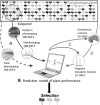Fortune telling: metabolic markers of plant performance
- PMID: 27729832
- PMCID: PMC5025497
- DOI: 10.1007/s11306-016-1099-1
Fortune telling: metabolic markers of plant performance
Abstract
Background: In the last decade, metabolomics has emerged as a powerful diagnostic and predictive tool in many branches of science. Researchers in microbes, animal, food, medical and plant science have generated a large number of targeted or non-targeted metabolic profiles by using a vast array of analytical methods (GC-MS, LC-MS, 1H-NMR….). Comprehensive analysis of such profiles using adapted statistical methods and modeling has opened up the possibility of using single or combinations of metabolites as markers. Metabolic markers have been proposed as proxy, diagnostic or predictors of key traits in a range of model species and accurate predictions of disease outbreak frequency, developmental stages, food sensory evaluation and crop yield have been obtained.
Aim of review: (i) To provide a definition of plant performance and metabolic markers, (ii) to highlight recent key applications involving metabolic markers as tools for monitoring or predicting plant performance, and (iii) to propose a workable and cost-efficient pipeline to generate and use metabolic markers with a special focus on plant breeding.
Key message: Using examples in other models and domains, the review proposes that metabolic markers are tending to complement and possibly replace traditional molecular markers in plant science as efficient estimators of performance.
Keywords: Breeding; Metabolic marker; Metabolomics; Plant performance; Prediction.
Conflict of interest statement
Compliances with ethical standards Conflict of Interest The authors declare that they have no conflict of interest. Ethical approval This study does not involve the use of animal or human samples.
Figures


References
-
- Anonymous. (2015). Growing access to phenotype data. [Editorial]. Nature Genetics, 47(2), 99–99. doi:10.1038/ng.3213. - PubMed
-
- Anonymous. (2016a). FAIR principles for data stewardship. [Editorial]. Nature Genetics, 48(4), 343–343. doi:10.1038/ng.3544. - PubMed
-
- Anonymous. (2016b). Purple plants. [Editorial]. Nature Genetics, 48(6), 587–587. doi:10.1038/ng.3585. - PubMed
Publication types
LinkOut - more resources
Full Text Sources
Other Literature Sources
Research Materials
Miscellaneous
